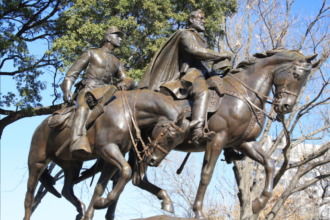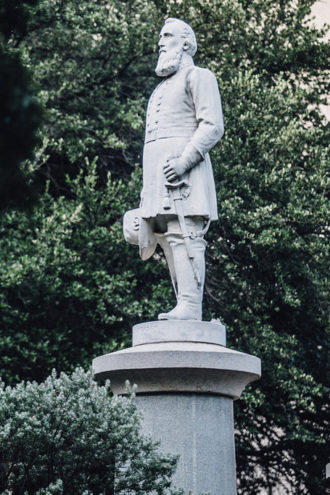About three months before Mayor Mike Rawlings publicly announced the formation of a task force to research the removal of the city’s Confederate statues from public parks, city staff began quietly exploring their options. City Manager T.C. Broadnax mobilized the Office of Cultural Affairs to inventory the existing statues under the city’s purview, and to determine the guidelines for decommissioning them. City staff even began developing a plan for their removal, getting a verbal estimate from a conservator who said that getting rid of the statues would cost about $1.6 million—less than half of what one council member has publicly touted.
This was in May, months before the violence in Charlottesville pushed the debate into the forefront here. Dallas has toed the water since the 2015 domestic terror attack at a predominantly black church in Charleston, South Carolina, which ended with nine lives lost at the hand of a young, white shooter who liked to pose with Confederate iconography. That tragedy is widely believed to be the impetus for statue removals in cities across America. But it wasn’t until this summer that Dallas’ leaders got involved and began building coalitions.
Despite public support from a majority of the council for removal, the task force is starting from a blank slate. It will not research simply what to do with the statues once they’re removed, but whether they should be removed at all. Representatives from both the mayor’s office and the Cultural Affairs Commission confirmed that.

City staff’s inventory found two confederate monuments in Dallas’ public art collection, Pioneer Park’s Confederate Veteran Memorial by Frank Teich, from 1896, and Lee Park’s Robert E. Lee and the Confederate Solider by Alexander Phimister Proctor, from 1936. There are five other pieces that depict the Confederacy in Fair Park. The first is one of Lawrence Tenney Stevens’ 1936 series of female allegorical figures that depict the six nations that had sovereignty over the state of Texas. The other is the Confederate Medallion. Both are in the Esplanade at Fair Park, near the long fountain. The last three are located in the Hall of State—the Great Seal of the Confederacy, a mural containing a Confederate battle flag, and bronze lanterns that include another female allegorical figure.
Being that these are part of the city’s public collection, changes are guided by Dallas’ Cultural Policy—but not governed. There are guidelines regarding decommissioning public art, and include stern language about the city’s decision: “deaccessioning should be a deliberate and seldom-used procedure.” The Public Art Committee, however, does have the ability to “recommend deaccessioning specific artworks on a case-by-case basis at any time.” But, again, the cultural policy is a guiding document, not a governing one, which frees the task force or city staff to go off script.
The council could use this research from city staff and quickly vote on what to do with the monuments based on recommendations from the Public Art Committee. Instead, Rawlings’ task force will take this research and launch its own expedition, delaying action for at least two months.
“If we received clear direction from the City Council to remove the monuments, I am confident we have the resources to come up with a viable plan to do so,” says Kay Kallos, the city’s public art program manager.
The task force, which will include input from the public as well as the Dallas Holocaust Museum and the grant-funded Truth, Racial Healing & Transformation organization, adds another Kafkaesque fold into the bureaucracy of decision making at City Hall. Other cities have moved much swifter. Consider Baltimore, whose mayor decided to order her city’s monuments removed in the dead of night, arguing that, “with the climate of this nation, I think it’s very important that we move quickly and quietly.” (It’s worth noting that Baltimore has a strong mayor/weak city manager system, opposite to Dallas.)

In Dallas, the Public Art Committee will make its recommendations based on the findings of the mayor’s task force rather than existing research of city staff. Some of the options include relocating the monuments, selling or trading them, removing and storing them, or removing them and permanently disposing of them. But, again, the mayor’s task force is not bound by the constraints of the city’s cultural policy.
The City Council has indicated broad support for removal. The details are where the disagreements occur. A coalition of five led by Councilman Philip Kingston and several of his white colleagues is calling for an immediate vote on the “expeditious” removal of the statues. A separate coalition of black councilmen led by Mayor Pro Tem Dwaine Caraway believes the task force is the route to pursue. No one currently knows the costs or the logistics of removal, they argue.
Kingston’s proposed measure will come up for a vote on September 27.
Here is what the mayor hopes will happen over the next two months. Ultimately, the mayor’s task force will investigate the issue and make its recommendation to the Public Art Committee. First, the task force will plan four meetings, two of which will allow for public input. The goal of these meetings is to identify the process, costs, and timeline for removing the monuments and other Confederate art. Currently, the task force is planning to present its findings to the Public Art Committee on October 3.
The Public Art Committee will make its recommendation to the Cultural Affairs Commission on October 12. That meeting will allow for public input and must be announced at least 24 hours prior. The Cultural Affairs Commission—chaired by John Paul Batiste, the former executive director of the Texas Commission on the Arts, and consisting of appointees from each council district, as well as three at-large members—will listen to the recommendation of the Public Art Committee and then vote on their own recommendation, presumably to amend, reject, or advance the recommendation of the Public Art Committee.
From there, the Cultural Affairs Commission involves the council by presenting its recommendation to the Quality of Life, Arts, and Culture committee, which consists of seven council members and is chaired by Sandy Greyson. That’s on October 23. The October 25 Council meeting will allow for public input on the statues. The Quality of Life, Arts, and Culture committee makes its recommendation on November 1. The Council, under this timeline, would vote on the fate of the statues on November 8, 11 weeks away.
Looking at support for removal, a majority of council members is in agreement. The task force does not appear to be in the business of persuasion, but instead of determining process—a process that city staff has already laid out, albeit without input from the nonprofits. However, determining process means delaying a vote. People who want the Confederate monuments to stay up have the most to potentially gain by the process in which the mayor and the black council members have endorsed—if the vote was held today, the result appears to be in overwhelming favor to remove the monuments. Since the end of this three-month process still culminates in a vote by the Dallas City Council, and if the City Council has already made up their minds on this issue, why not expedite the vote?
In interviews, members of the Public Arts Committee raised that question. City staff has inventoried the statues, established the policies required for removal, researched the approaches of peer cities, and determined cost estimates.
“They are capable of coming up with viable plans,” Batiste says of city staff. “This is what they do, and they should have the opportunity to add to their expertise to the process.”

The delay also means that the costs to secure these monuments is likely to increase. Baltimore Mayor Catherine Pugh cited this as a reason she ordered the city’s statues removed: “I … wanted to protect my city from any of the violence that was occurring around the nation.” Protesters for and against the monuments will continue to have rallies and demonstrations—as they should. The city of Dallas will continue to pay extra security costs for police and other staff members. Dallas police will be forced to continue to perform the difficult but critical tasks of keeping the public safe while not violating individual rights.
As more cities move swiftly in removing their monuments, Dallas will become one of the few major municipalities that will still be in the process of deciding. This will focus attention and resources on our city by outside groups and media, both for and against removal, but most concerning is the attention by white supremacists and neo-fascists who have a history and present day presence in Dallas. Large demonstrations by neo-fascists and white supremacists in our city risks escalating the potential for violence, and definitely deepens divisions, which is the opposite of the intent of this process: unite the city.
There is a sincere desire by the mayor and council to use this moment to have a meaningful conversation about race in our city. The process has been created to maximize the amount of public input into the debate over what to do with Dallas’ Confederate art, and in a vacuum that might very well be a good thing. However, in the context of the majority of City Council already making up their minds on the issue, of security costs outweighing removal costs, and of public safety concerns as Dallas becomes a national flashpoint for this contentious debate, it is worth considering: who really benefits from trusting this process?
EDITOR’S NOTE: Originally we reported it would be unlikely for Kingston’s proposed measure to go to vote before November 8. We changed the copy to reflect the new date of September 27, as updated late Wednesday.





